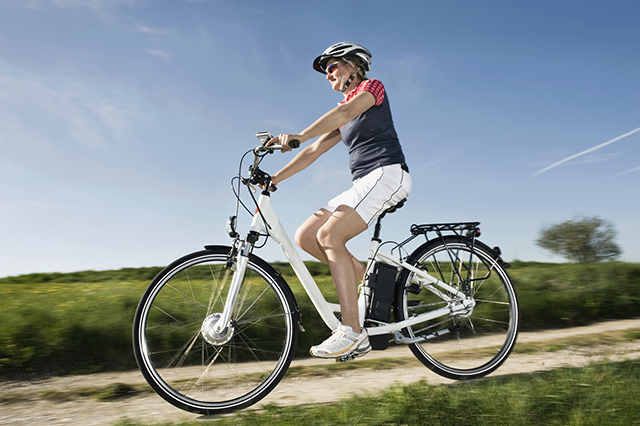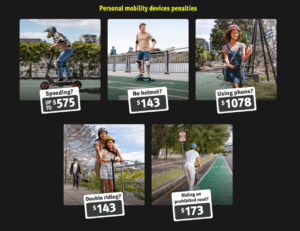Following reported safety concerns regarding the use of motorised bikes and scooters, the sharing of pathways, possible bicycle registration and more, the following information (in italics) has been provided by the Department of Transport and Main Roads:
Bicycle riding is valued for the important contribution it makes to developing a sustainable and effective transport system. Bicycle riding has significant benefits for health, the environment and tourism, as well as positive local impacts in connecting communities. It is a popular choice for commuting, and bike riders are legitimate road users with equal rights and responsibilities.
Legitimate power-assisted bicycles are recognised as a viable transport option to those who benefit from the assistance of low powered electric motors. Like standard bicycles they can be used on roads and footpaths.
There are currently two types of power-assisted bicycles that are considered legal to be used in Queensland on a road or road-related area, such as a footpath or path. The first type has an auxiliary electric motor that is not capable of generating more than 200 watts of power. The auxiliary motor provides assistance only, with the pedals being the primary source of power. If the bicycle can be propelled by the motor alone, without the pedals being used, then the motor is not auxiliary.
The second type of power-assisted bicycle is a ‘pedalec’. Pedalecs must comply with the European Standard for Power Assisted Pedal Cycles (EN15194) and can have an auxiliary electric motor that provides up to 250 watts of power. A pedalec’s motor must cut out at 25 kilometres per hour, irrespective of whether the pedals are being used, and must only provide initial assistance without pedalling up to a maximum speed of six kilometres per hour. Once the vehicle has reached six kilometres per hour, the motor will not operate unless the bicycle is being pedalled.
Motorised bicycles that do not fit within the legal definition are classed as non-compliant motorbikes because they do not comply with the Australian Design Rules (ADR) requirements for a motorbike. Vehicles that do not comply with ADRs may only be ridden on private property where there is no public access.
There have been numerous suggestions to have bicycles registered, however, as bicycles do not have identification numbers like motor vehicles (a vehicle has an identification number on the chassis) to record on the vehicle register, it would be very difficult to ensure that the number plate provided to one bicycle rider was not being used by another.
The absence of identifiers would also make it difficult to record and maintain details, such as transfer of plates in the vehicle register, making enforcement problematic. This would also see the requirement for children’s bicycles to be registered and there would be cost impositions. It should be noted that many bicycle riders currently pay registration on a vehicle. Even a modest fee would impact on those Queenslanders who cannot afford to pay multiple registration fees and would likely deter people from bicycle riding.
Therefore, the costs to develop and administer a bicycle registration scheme and costs to members of the public to register their bicycles far outweigh any potential benefits. Bicycle riders committing road rule offences cannot be identified as easily as motorists. Most offences committed by bicycle riders need to be observed firsthand. No other jurisdiction in Australia currently requires bicycles to be registered and there are no plans for bicycles to be registered in Queensland.
For the above reasons, there are no plans to implement a registration scheme or age limit for electric bicycles in Queensland.
Current Speed Limits for e-scooters (Personal Mobility Devices) include:
- Footpaths — 12km/h maximum
- Shared paths —12km/h maximum (unless signed otherwise)
- Separated paths—25km/h maximum (unless signed otherwise)
- Bicycle paths — 25km/h maximum (unless signed otherwise)
Electric Bikes limitations:
The following information (in italics) has also been provided by the Department of Transport and Main Roads:
Unlike Personal Mobility Devices, there is no defined speed limit for power assisted bikes under the QRRs. A bike rider must comply with the signed speed limit of the infrastructure they are riding on – for example where a road is signed at 50 km/h, or a shared zone signed at 10 km/h.
However, electric bikes do have limitations on how fast the bike may travel when propelled only by its motor. The motor of a power-assisted bike must only provide assistance to the person pedalling. If the bike can be propelled by the motor alone, without the pedals being used, then it is an illegal device.
Furthermore, the motor must stop operating at 25 kilometres per hour. However, there is provision for the motor on a power-assisted bike to operate without pedalling up to six kilometres per hour, to provide initial assistance to get going.
These requirements ensure that only bikes that are considered safe are allowed to be used on roads and paths, particularly for interactions with pedestrians. Devices that are too powerful, have the motor as the primary source of power, or are capable of higher speeds, represent a safety hazard. In particular, footpath users could be seriously injured by these devices.
If you witness any breaches of the Queensland Road Rules, we encourage to report these to the Queensland Police Service (QPS) by emailing Policelink at policelink@police.qld.gov.au or by calling on 131 444.
The following graphic contains the type of fines, rule breakers can face:
Advocacy for safety improvements and better enforcement in shared spaces such as pathways, and also for better compliance monitoring of the current regulations by users of motorised bikes and scooters, is ongoing. Should you wish to add your voice to these efforts, please email the Minister for Police via police@ministerial.qld.gov.au and Minister for Transport & Main Roads via transportandmainroads@ministerial.qld.gov.au and cc to our office via noosa@parliament.qld.gov.au.
Should you require any further information or assistance, please email our office via noosa@parliament.qld.gov.au.


